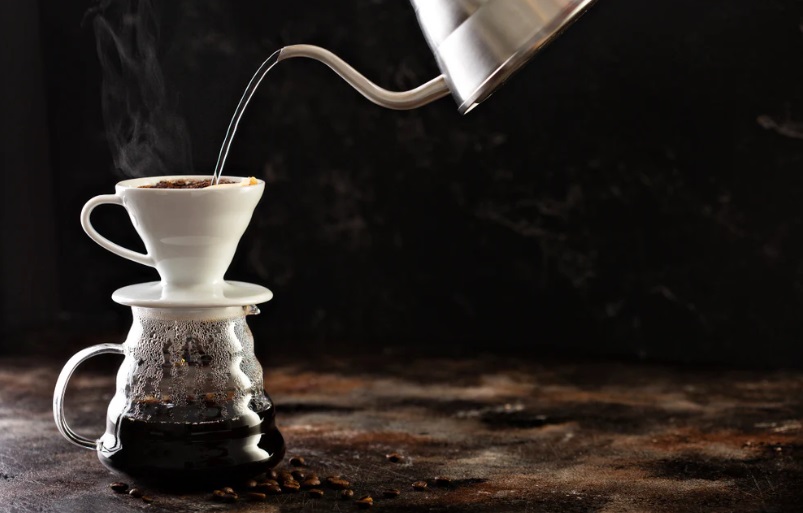
Brewing the perfect cup of drip coffee is as much an art as it is a science, with water temperature playing a pivotal role. The heat of the water when it meets the coffee grounds can make or break your brew. The ideal temperature for extracting the richest flavor without burning the coffee is between 195°F and 205°F (90°C to 96°C). Achieving this temperature balance is crucial because it directly affects how the flavors and oils are extracted from the coffee beans, influencing the taste and aroma of your coffee.
Key Takeaways for Brewing Drip Coffee
- Consistency is Key: Maintaining a consistent water temperature each time you brew can significantly enhance your coffee’s reliability in flavor.
- Impact on Flavor Extraction: The right temperature helps in optimally extracting the complex flavors of coffee. Too hot, and you risk bitterness; too cool, and the brew may taste weak.
- Achieving Optimal Temperature: Not everyone has access to fancy gadgets. A simple kitchen thermometer can serve the purpose, or you can bring water to a boil and let it sit for 30 seconds to reach the approximate range.
Achieving the Ideal Water Temperature
Getting your water temperature just right is crucial for the perfect cup of drip coffee. Let’s explore both high-tech and low-tech ways to manage this critical brewing factor.
Using Tools for Precision
For those who love gadgets and strive for precision, a few tools can make achieving the perfect water temperature easier:
- Thermometers: A simple kitchen thermometer can check your water’s heat before you pour. It’s a straightforward way to ensure your water is within the ideal range of 195°F to 205°F.
- Variable-Temperature Kettles: These are a coffee enthusiast’s best friend. They allow you to set an exact temperature for heating the water, taking the guesswork out of the process.
Low-Tech Methods
Not everyone wants to invest in extra kitchen gadgets. Fortunately, you can still get close to the ideal temperature without them:
- Boil and Wait: The most accessible method is to bring water to a boil and then let it sit for about 30 seconds. Typically, boiled water reaches 212°F, and the brief wait allows it to cool to within the ideal range.
- Cold Finger Test: An old-school trick is to dip a cleaned finger briefly into the water. If you can stand it for a moment but it’s still quite hot, it’s likely just about right. This method is less precise and requires caution, but it gets easier with practice.
Influence of Altitude and Climate on Boiling Point
The boiling point of water isn’t a constant and varies with altitude and climate. At higher altitudes, water boils at a lower temperature due to decreased air pressure. This means if you’re brewing your coffee in the mountains, your boiling water might be less than the ideal 195°F to 205°F, potentially under-extracting your coffee.
Conversely, in lower altitudes, achieving the optimal range is straightforward. Climate also plays a role; in colder environments, your water might cool faster, affecting how you manage brewing time and temperature.
How Different Brewing Machines Manage Temperature
Different brewing machines come with various features to handle water temperature. Advanced models have built-in water heating elements that allow precise temperature control. These machines actively monitor and adjust the temperature during brewing, ensuring consistency.
Simpler models might not offer this control, which means more manual monitoring. Understanding how your specific coffee maker handles temperature can help you make adjustments for better brews.
Impact of Temperature Changes on Coffee Strength and Flavor
Slight variations in water temperature can significantly affect your coffee’s strength and overall flavor profile. Water that’s too hot can cause over-extraction, leading to bitter flavors. On the other hand, water that’s not hot enough might not extract enough flavor, resulting in a weak or sour cup. The sweet spot, typically between 195°F and 205°F, ensures optimal extraction of coffee oils and flavors.
Experimenting with Temperature Variations
To find what best suits your taste, don’t be afraid to experiment with temperature adjustments. If you prefer a stronger, more robust flavor, aim for the higher end of the temperature range. For a lighter taste, slightly cooler water might work better.
Keeping a log of temperatures and taste outcomes can be a fun and informative way to refine your brewing technique to suit your personal preference perfectly.
Common Mistakes to Avoid with Water Temperature
Avoiding common mistakes with water temperature can greatly improve your coffee experience:
- Overheating Water: Boiling water can scald coffee grounds, leading to a burnt flavor. It’s crucial to let boiling water cool slightly to fall within the ideal range of 195°F to 205°F before brewing.
- Insufficient Heat: Similarly, not heating water enough results in under-extraction. Coffee brewed with water that’s too cool may taste weak or sour because the desirable flavors aren’t fully extracted.
FAQs
What is the best temperature for a strong brew?
For a stronger brew, aim towards the higher end of the optimal range, around 205°F. This temperature maximizes extraction without imparting bitterness.
How does water temperature impact the acidity of coffee?
Higher temperatures can enhance the extraction of acidic compounds, making the coffee taste brighter and more acidic. If you prefer less acidity, try brewing at the lower end of the temperature spectrum.
Can I use boiling water for drip coffee?
It’s best to avoid using boiling water directly as it can over-extract the coffee, leading to bitterness. Let the water cool for about 30 seconds after boiling to reach the ideal temperature.
Final Thoughts
Mastering water temperature is essential for brewing the perfect cup of drip coffee. It’s a balance that impacts flavor, strength, and overall enjoyment. Experimenting within the recommended temperature range can help you discover the perfect settings for your taste.









